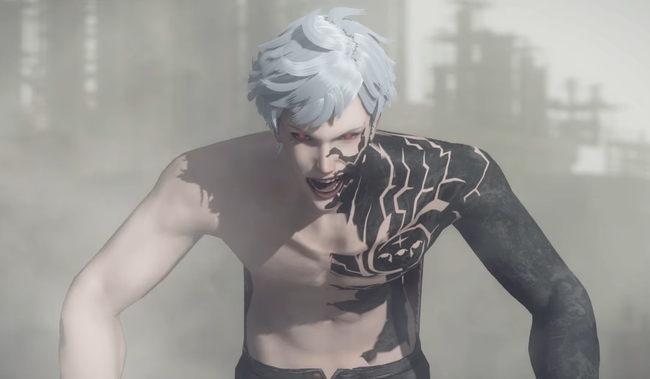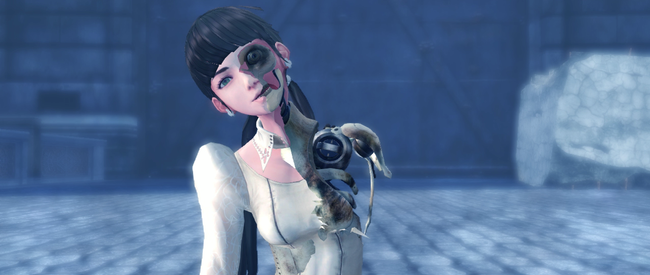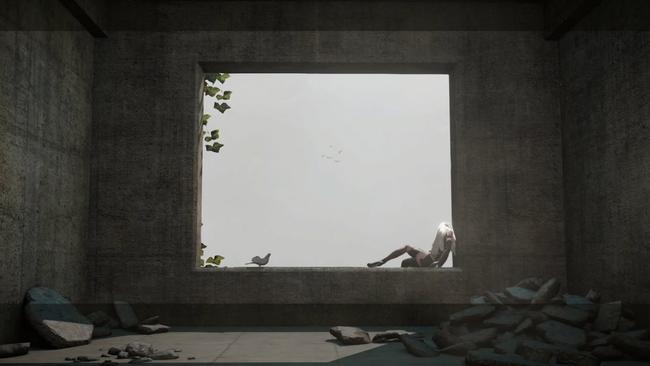
Observing NieR: Automata's world and how players help realize its future
Warning: This article contains spoilers for the entire NieR and Drakengard series.
Just last month, discussion surrounding the future of the NieR series was brought forth in a Famitsu interview with the minds behind NieR: Automata. Producer Yosuke Saito and Director Yoko Taro have clearly expressed that if they were able to gather the same dream team once again, a sequel may be greenlit.
Left astounded by NieR: Automata’s narrative, I can’t help but speculate what sort of story Taro plans to tell next. I reckon it would probably still be in the world of NieR.
I’ve found myself neck-deep studying this franchise’s chilling lore extensively. Following the trail of Yoko Taro’s works involves trying to pinpoint which events in Drakengard and NieR have yet to be developed in any game, novel, drama CDs, and other mediums.
To put things into perspective, Taro’s unique universe spans more than 10,000 years of history with multiple timelines that construct the stories of Drakengard and NieR. If you’re a newcomer who jumped into Automata first, you may have been overwhelmed by the huge influx of discussions about how the two series are related, the references on characters or locations, and Taro’s portrayal of “happy endings”.
There is so much to digest in his deceptively straightforward narratives. Nonchalantly mentioning historical events in these two series tend to make a gigantic impact overtime. While this element certainly adds meaningful world building, it’s not really imperative to learn all of them to grasp the stories Yoko Taro wants to tell.
Much of Taro’s writing style has allowed characters’ personal developments to be right at the forefront of the story’s focus; this gives his games enough flexibility to stand alone in an advantageous fashion. It doesn’t matter if you know about the significance of the Red Eye’s appearance or the mention of the Flower in NieR: Automata as long as you understood the story’s examination of the rawest human emotions through its cast.

With that said, it is what makes the history and lore even more fascinating to me. Trying to understand the flow of historical events through his games is akin to witnessing a grand tale of humanity’s journey in a mesmerizing way. There is certainly a separation between the character-driven narrative and the universe the cast inhabits. It evokes a disparate feeling of rebellion against their struggles and the world’s ultimate fate.
The endless battle against The Watchers’ plans to erase humanity is the overarching conflict in his tales. I believe this will continue to be essential for the series going forward.
Lore, Timelines, and the Player as an Observer
If you happen to be a casual fan, you’re probably thinking I’m crazy right now. Why on Earth am I emphasizing the lore if it’s not a complete necessity to the core of Yoko Taro’s storytelling? Is lore consistency important for his next games?
Truthfully, I believe that his works have been structured in a rather meticulous way. They are undoubtedly layered, standalone stories with an emotional narrative. On top of that, there are usually very subtle plot points and nods for series veterans to decipher. Now couple all of that with the unconventional character studies and dark themes he’s famous for; that is the concoction for the Yoko Taro experience.
After watching Drakengard 3’s last ending however, I’m convinced that Yoko Taro’s brain is also on the same wavelength as Zero Escape’s Kotaro Uchikoshi. Taro values the actual player’s role in his tales as an existing observer of their history, and it’s becoming more obvious through each game he directs.

Yoko Taro’s debut as a game director with Drakengard quickly garnered attention for good reason. The story’s generic setting hid a twisted narrative with Caim’s madness at its center. It may be a rough introduction to players, but it introduces some of the most significant key players in the lore with dragons, the Watchers, and more.
In order to unlock all endings, certain requirements had to be met. The cruelest one was acquiring all weapons and in a game like Drakengard, it certainly isn’t an entertaining activity to strive toward. Multiple endings are a common feature in games of course, but Drakengard’s take struck me. Endings are not only mere alternate conclusions in the case of Drakengard. Each consecutive finale serves as build-up for the true last ending - and it happens to be the timeline that leads to the events of NieR.
It’s not until NieR where Yoko Taro finally capitalizes on effective storytelling via multiple playthroughs; this reminded me of how several visual novels handled similar concepts. As the player in NieR, you exclusively learn more about Kaine’s backstory and the Shades’ perspectives in the 2nd playthrough; meanwhile, the protagonists do not gain this insight.
The infamous sacrifice of your save files is introduced to save Kaine’s life in the last ending, erasing all the memories of the protagonist in the entire world of NieR. Yoko Taro claims he experimented with the emotional investment gamers have with their save files through this decision. It proved to be an essential element of the game’s impact in making the player feel more attached. Thus, it still remains as one of the most outstanding legacies of that game.

Tick. Tock. Tick. Tock. I remember staring at my screen for five whole minutes when I watched the last ending of Drakengard 3.
I played Drakengard 3 before NieR: Automata, but I never obtained the last set of endings. Oddly enough, I ended up finishing the latter first before closing the book on the former; this resulted in a mind-boggling experience for me. You have to understand that I was coming straight from finishing a story about tragic androids and machines which depressed me to no end.
The last thing I expected from Drakengard 3, chronologically set before the first medieval-influenced Drakengard game, is that Accord herself was an android model that sent her reports to the Old World.
The Old World is later referred to in NieR: Automata as the millennia before the game’s events. Accord acted as a narrator who was both directly communicating with the player and Drakengard 3’s protagonist, Zero, about her job to observe the outcomes of different timeline branches.
Yoko Taro never provided a straightforward explanation on the real meaning behind his multiple what-if scenarios. He employs it as a clever tactic to showcase the potential of the videogames medium in storytelling. We witnessed four character “routes” in NieR: Automata: 2B, 9S, A2, and the player’s own one in Ending E. The last one featured the biggest involvement of players themselves in his games thus far.
The shooting minigame of the credits roll served as the entire last ending, urging the player to destroy the “gods” that developed Automata alongside other players around the world. Only players who sacrificed their save files were able to help those in need during Ending E. This same choice for your own save file to become a martyr is offered to you by the Pods in the end. Thus, it wrapped up Automata’s gripping conflict about human relationships and their state of loneliness - now with the revival of 2B, 9S, and A2 ensured through the player’s will.
(Side-note: Drakengard 2 acts as a filler as it was not written nor directed by Yoko Taro)
NieR Timeline Overview

1) Cataclysm --- 2) Drakengard 3 --- 3) Drakengard 1 --- 4) NieR --- 5) NieR: Automata
-
The Cathedral City appears out of nowhere in Earth: its appearance confirmed in Drakengard 3 looking like a modern-day urban city ruins; hailed as the source of magical knowledge and dragons from the Gods; the parasite Flower is born inside the city and takes over Zero; Zero attempts suicide but only gives birth to her younger sisters; the Flower threatens humanity through the Intoner siblings’ rule
-
The war between the sibling Intoners; all sisters perish and Zero is killed by One’s twin brother; Brother One establishes the Cult of The Watchers in memory of his sister; the Flower’s fate is uncertain
-
The Red Eye Disease appears in Brother One’s cult and spreads; The Watchers’ existence is confirmed as the series’ gods who want to erase humanity; Caim and the Red Dragon fight the Queen Beast who commands the Watchers and are transported through spacetime in modern day Tokyo in 2003
-
The Queen Beast’s corpse discharges Maso particles, causing the spread of the White Chlorination Syndrome; Project Gestalt is launched to save humanity by separation of soul and body; Red Eye makes an appearance through an organization called Legion; androids are created to oversee the Replicants’ system; Gestalts are annihilated leading to humanity’s extinction
-
Space war: alien invasion; machines overpower the aliens and take over the world; Project YoRHa is launched for the war against the machines; the human genome is preserved in the moon server; Red Eye appears driving machines and androids berserk; the Flower is mentioned by a Red Eye YoRHA soldier during the fall of the Bunker; the ark is launched into space-time containing machine information and the Red Girls; the real founder of YoRHA, an android, is yet to be revealed
Year of Release
-
Drakengard 1 (Release year: 2003)
-
NieR (Release year: 2010)
-
Drakengard 3 (Release year: 2014)
-
NieR: Automata (Release year: 2017)
This brief overview may already be convoluted enough to see any sort of complete order and cohesion between the games. I feel as if the player’s involvement, albeit only present near the endings, serves as a consistent glue between all of them though.
Yoko Taro has made sure that the player will be considered as an observing entity within the universe that inevitably influences its potential to expand in different directions.
There is an inherent restriction in this idea because of common game design constraints, yet players are given the illusion to think beyond possibilities. Therefore, it strengthens the relationship between the games and the player- all while establishing the emotional attachment to their cast and history as an observer.
There is so much left to be explored in NieR’s universe. Perhaps we’ll see a more evolved population on Earth after Automata or explore the past with the outbreak of WCS in the modern-day era. I for one am very much ready to play my role as an observer of another eccentric and powerful tale in Yoko Taro’s world - and I'm interested to see where he'll take things next.